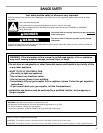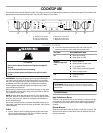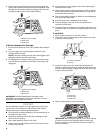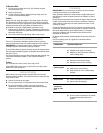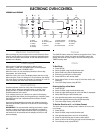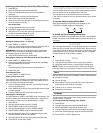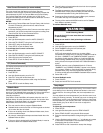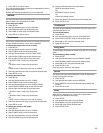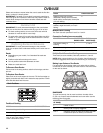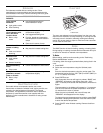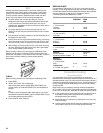
9
To Remove Grill:
1. Be sure control knobs are in the “Off” position and grill
components are cool.
2. Remove grill grates.
3. Lift the burner up slightly. Slide the burner away from the
orifices and terminal receptacle.
To Use:
Before first use, wash grill grates in hot soapy water, rinse and
dry. Season the surface by wiping on a thin coating of cooking
oil. Remove excess oil by wiping with a paper towel. Repeat the
seasoning process when grill grates are cleaned in the
dishwasher or anytime a sugar-based marinade is used.
1. Preheat grill on High for 5 minutes. Preheating improves the
flavor and appearance of meats and quickly sears the meat to
help retain the juices.
2. Turn knob to desired cook setting. Place food on grill.
Downdraft Ventilation System
The built-in downdraft ventilation system removes cooking
vapors, odors and smoke from foods prepared on the cooktop.
IMPORTANT: For optimal performance, operate downdraft
ventilation system with the filter properly installed.
To avoid the buildup of grease, the filter should be cleaned often.
The downdraft ventilation system will operate automatically when
the grill is in use.
For more information on proper filter placement and cleaning, see
“Downdraft Ventilation System” in the “General Cleaning”
section.
To Use:
The ventilation fan can be set to Low, High or Off.
Press VENT FAN once for Low, a second time for High, and a
third time to turn the fan Off.
Home Canning
When canning for long periods, alternate the use of surface
burners between batches. This allows time for the most recently
used areas to cool.
■ Center the canner on the grate.
■ Do not place canner on 2 surface burners at the same time.
■ For more information, contact your local agricultural
department. Companies that manufacture home canning
products can also offer assistance.
Cookware
IMPORTANT: Do not leave empty cookware on a hot surface
cooking area, element or surface burner.
Ideal cookware should have a flat bottom, straight sides and a
well-fitting lid, and the material should be of medium-to-heavy
thickness.
Rough finishes may scratch the cooktop or grates. Aluminum and
copper may be used as a core or base in cookware. However,
when used as a base they can leave permanent marks on the
cooktop or grates.
Cookware material is a factor in how quickly and evenly heat is
transferred, which affects cooking results. A nonstick finish has
the same characteristics as its base material. For example,
aluminum cookware with a nonstick finish will take on the
properties of aluminum.
Cookware with nonstick surfaces should not be used under the
broiler.
Use the following chart as a guide for cookware material
characteristics.
COOKWARE CHARACTERISTICS
Aluminum
■ Heats quickly and evenly.
■ Suitable for all types of cooking.
■ Medium or heavy thickness is best for
most cooking tasks.
Cast iron
■ Heats slowly and evenly.
■ Good for browning and frying.
■ Maintains heat for slow cooking.
Ceramic or
Ceramic glass
■ Follow manufacturer’s instructions.
■ Heats slowly, but unevenly.
■ Ideal results on low to medium heat
settings.
Copper
■ Heats very quickly and evenly.
Earthenware
■ Follow manufacturer’s instructions.
■ Use on low heat settings.
Porcelain
enamel-on-
steel or cast
iron
■ See stainless steel or cast iron.
Stainless steel
■ Heats quickly, but unevenly.
■ A core or base of aluminum or copper
on stainless steel provides even
heating.





